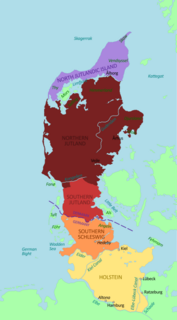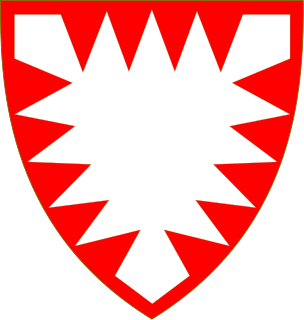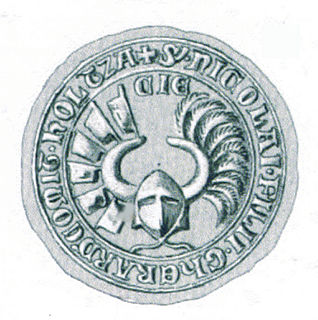Related Research Articles

Holstein is the region between the rivers Elbe and Eider. It is the southern half of Schleswig-Holstein, the northernmost state of Germany.
Albert I was a Duke of Saxony, Angria, and Westphalia; Lord of Nordalbingia; Count of Anhalt; and Prince-elector and Archmarshal of the Holy Roman Empire. Even though his grandfather Albert the Bear had held the Saxon dukedom between 1138 and 1142, this Albert is counted as the first.

The Counts of Schauenburg and Holstein were titles of the Frankish Empire. The dynastic family came from the County of Schauenburg near Rinteln on the Weser in Germany. Together with its ancestral possessions in Bückeburg and Stadthagen, the House of Schauenburg ruled the County of Schauenburg and the County of Holstein. The comital titles of Holstein were subject to the liege lord, the Dukes of undivided Saxony till 1296, and thereafter the Dukes of Saxe-Lauenburg.

The House of Schaumburg was a dynasty of German rulers. Until c. 1485, it was also known as the House of Schauenburg. Together with its ancestral possession, the County of Schaumburg, the family also ruled the County of Holstein and its partitions Holstein-Itzehoe, Holstein-Kiel, Holstein-Pinneberg, Holstein-Plön, Holstein-Segeberg and Holstein-Rendsburg and through the latter at times also the Duchy of Schleswig.

The Duchy of Saxe-Wittenberg was a medieval duchy of the Holy Roman Empire centered at Wittenberg, which emerged after the dissolution of the stem duchy of Saxony. The Ascanian dukes prevailed in obtaining the Saxon electoral dignity until their duchy was finally elevated to the Electorate of Saxony by the Golden Bull of 1356.

The County of Schaumburg, until ca. 1485 known as Schauenburg, was a state of the Holy Roman Empire, located in the present German state of Lower Saxony. Its territory was more or less congruent with the present district Landkreis Schaumburg.
Holstein-Glückstadt or Schleswig-Holstein-Glückstadt is the historiographical name, as well as contemporary shorthand name, for the parts of the duchies of Schleswig and Holstein that were ruled by the Kings of Denmark in their function as dukes of Schleswig and Holstein, thus also known as Royal Schleswig-Holstein. Other parts of the duchies were ruled by the Dukes of Schleswig-Holstein-Gottorp. The territories of Holstein-Glückstadt are located in present-day Denmark and Germany. The main centre of administration was Segeberg and from 1648 Glückstadt on the River Elbe.
John I ruled as duke of Saxony from 1260 until 1282.
Albert II of Saxony was a son of Duke Albert I of Saxony and his third wife Helen of Brunswick and Lunenburg, a daughter of Otto the Child. He supported Rudolph I of Germany at his election as Roman king and became his son-in-law. After the death of their father Albert I in 1260 Albert II jointly ruled the Duchy of Saxony with his elder brother John I, and thereafter with the latter's sons.

The Kalkberg is a 91-metre-high rock in the center of Bad Segeberg. The name is a misnomer as it is not made of limestone, but from gypsum.

Holstein-Plön was the name of a county ruled by the House of Schauenburg that ruled in Holstein and Stormarn from 1110/11. The county emerged before 1295 when the County of Holstein-Itzehoe was partitioned after the death of Count Gerhard I of Holstein-Itzehoe into the counties of Holstein-Plön, Holstein-Pinneberg and Holstein-Rendsburg.

Gerhard VI was the Count of Holstein-Rendsburg from 1382, and Duke of Schleswig as of 1386.

Gerhard I, Count of Holstein-Itzehoe was the only count of Holstein-Itzehoe.

John I, Count of Holstein-Kiel was a member of the House of Schauenburg. He was Count of Holstein-Kiel from 1261 until his death.

John II, nicknamed the one-eyed (1253–1321) was the ruling count of Holstein-Kiel from 1263 to 1316.

Nicholas, Count of Schauenburg and Holstein-Rendsburg was a titular Count of Schauenburg. Together first with his brother and then with his nephews, Nicholas was the co-ruling Count of Holstein-Rendsburg from 1340 until his death. In 1390 Nicholas and his nephews inherited Holstein-Kiel, which itself included former Holstein-Plön through reversion in 1350. So except of Holstein-Pinneberg Nicholas and his nephews had united all of Holstein. He was also co-ruler of Schleswig from 1375 to 1386. He was thus a leading member of the House of Schauenburg and an influential figure in the area north of the Elbe. He was the second son of Count Gerhard III of Holstein-Rendsburg and his wife, Sophia of Werle.

Adolph V, Count of Holstein-Segeberg was the ruling count of Holstein-Kiel from 1263 to 1273 and of Holstein-Segeberg from 1273 until his death.

The County of Holstein-Pinneberg was a small territory which existed from 1290 until 1640, centred around Pinneberg in modern-day Schleswig-Holstein, Germany.
The imperial county of Holstein-Kiel was a line of the House of Schauenburg and Holstein from 1261 to 1390.
References
- ↑ Gerhard Köbler: Historisches Lexikon der Deutschen Länder: die deutschen Territorien vom Mittelalter bis zur Gegenwart. Verlag C.H. Beck, 2007, ISBN 978-3-406-54986-1, p. 297.
- ↑ Primary source: Schleswig-Holsteinische Regesten und Urkunden 6, p. 815 (No. 1148). Secondary source: Habermann, Jan: Spätmittelalterlicher Niederadel im Raum nördlich der Elbe. Norderstedt 2015, p. 312.